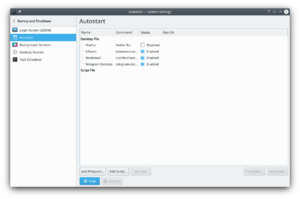System Settings/Startup and Shutdown/zh-cn: Difference between revisions
No edit summary |
(Updating to match new version of source page) |
||
| Line 1: | Line 1: | ||
<languages /> | <languages /> | ||
= | {|class="tablecenter vertical-centered" | ||
|[[Image:Settings-startup-and-shutdown.png|300px|thumb|center]] | |||
|Settings affecting startup and shutdown of your workspace | |||
|} | |||
{{PreferenceHelp}} | |||
__TOC__ | |||
{{PrefIcon|System-run.png|Autostart}} | |||
您能在这里设定登录 [[Special:myLanguage/Plasma|Plasma 桌面工作空间]]时运行的程序或脚本。添加一直运行的程序,如 [[Special:myLanguage/KAlarm|KAlarm]] 或 [[Special:myLanguage/KTorrent|KTorrent]]。 | 您能在这里设定登录 [[Special:myLanguage/Plasma|Plasma 桌面工作空间]]时运行的程序或脚本。添加一直运行的程序,如 [[Special:myLanguage/KAlarm|KAlarm]] 或 [[Special:myLanguage/KTorrent|KTorrent]]。 | ||
Clicking <menuchoice>Add Program...</menuchoice> opens the usual application picker dialog from which you can select an application. A desktop file for the application will be created in the autostart folder. When you have selected an application a <menuchoice>Properties</menuchoice> dialog will open. Just click <menuchoice>OK</menuchoice> and you are done. You can modify the properties of the application later: select the application in the list and click <menuchoice>Properties</menuchoice> to bring up the dialog again. | |||
You can temporarily suspend automatic start up of an application by deselecting the check box in the <menuchoice>Status</menuchoice> column. You can also specify that the application should only start when you log in to a KDE session. To do that, select the application, click <menuchoice>Advanced</menuchoice> and mark the check box. | |||
Clicking the <menuchoice>Add Script...</menuchoice> you will be asked for the path to a script; write the path in the text box or click the {{Icon|document-open}} button to get a file picker dialog. If you deselect the <menuchoice>Create as symlink</menuchoice> option the script file will be copied to the autostart folder; otherwise a link will be created. You can use the <menuchoice>Properties</menuchoice> and <menuchoice>Advanced</menuchoice> buttons in the same way as for applications. | |||
With scripts you have one further option: in the <menuchoice>Run On</menuchoice> column you will find a dropdown list with three options: <menuchoice>Startup</menuchoice>, <menuchoice>Shutdown</menuchoice> and <menuchoice>Pre-KDE Startup</menuchoice>, which determine when the script is run - at startup (after the desktop is started), when you log out, or during start up of the desktop, respectively. Note, that to use either of the last two options, the script must have the <tt>.sh</tt> extension. | |||
{{PrefIcon|Preferences-system-session-services.png|Service Manager}} | |||
{{PrefIcon|Preferences-system.png|Session Management}} | |||
<span class="mw-translate-fuzzy"> | |||
[[Category:桌面/zh-cn]] | [[Category:桌面/zh-cn]] | ||
[[Category:系统/zh-cn]] | [[Category:系统/zh-cn]] | ||
[[Category:配置/zh-cn]] | [[Category:配置/zh-cn]] | ||
</span> | |||
Revision as of 08:51, 1 September 2011
 |
Settings affecting startup and shutdown of your workspace |


Autostart
您能在这里设定登录 Plasma 桌面工作空间时运行的程序或脚本。添加一直运行的程序,如 KAlarm 或 KTorrent。
Clicking opens the usual application picker dialog from which you can select an application. A desktop file for the application will be created in the autostart folder. When you have selected an application a dialog will open. Just click and you are done. You can modify the properties of the application later: select the application in the list and click to bring up the dialog again.
You can temporarily suspend automatic start up of an application by deselecting the check box in the column. You can also specify that the application should only start when you log in to a KDE session. To do that, select the application, click and mark the check box.
Clicking the you will be asked for the path to a script; write the path in the text box or click the ![]() button to get a file picker dialog. If you deselect the option the script file will be copied to the autostart folder; otherwise a link will be created. You can use the and buttons in the same way as for applications.
button to get a file picker dialog. If you deselect the option the script file will be copied to the autostart folder; otherwise a link will be created. You can use the and buttons in the same way as for applications.
With scripts you have one further option: in the column you will find a dropdown list with three options: , and , which determine when the script is run - at startup (after the desktop is started), when you log out, or during start up of the desktop, respectively. Note, that to use either of the last two options, the script must have the .sh extension.

Service Manager

Session Management
